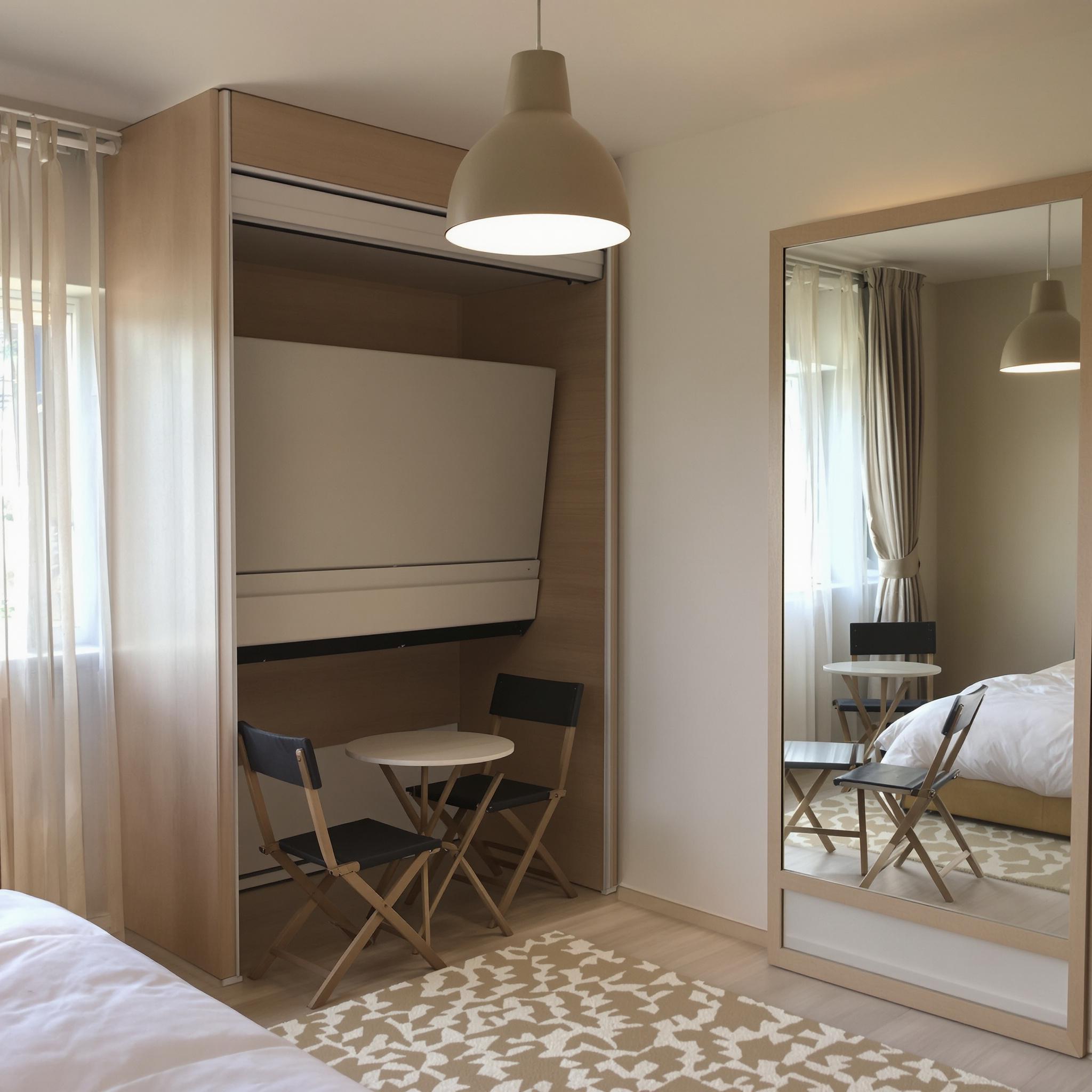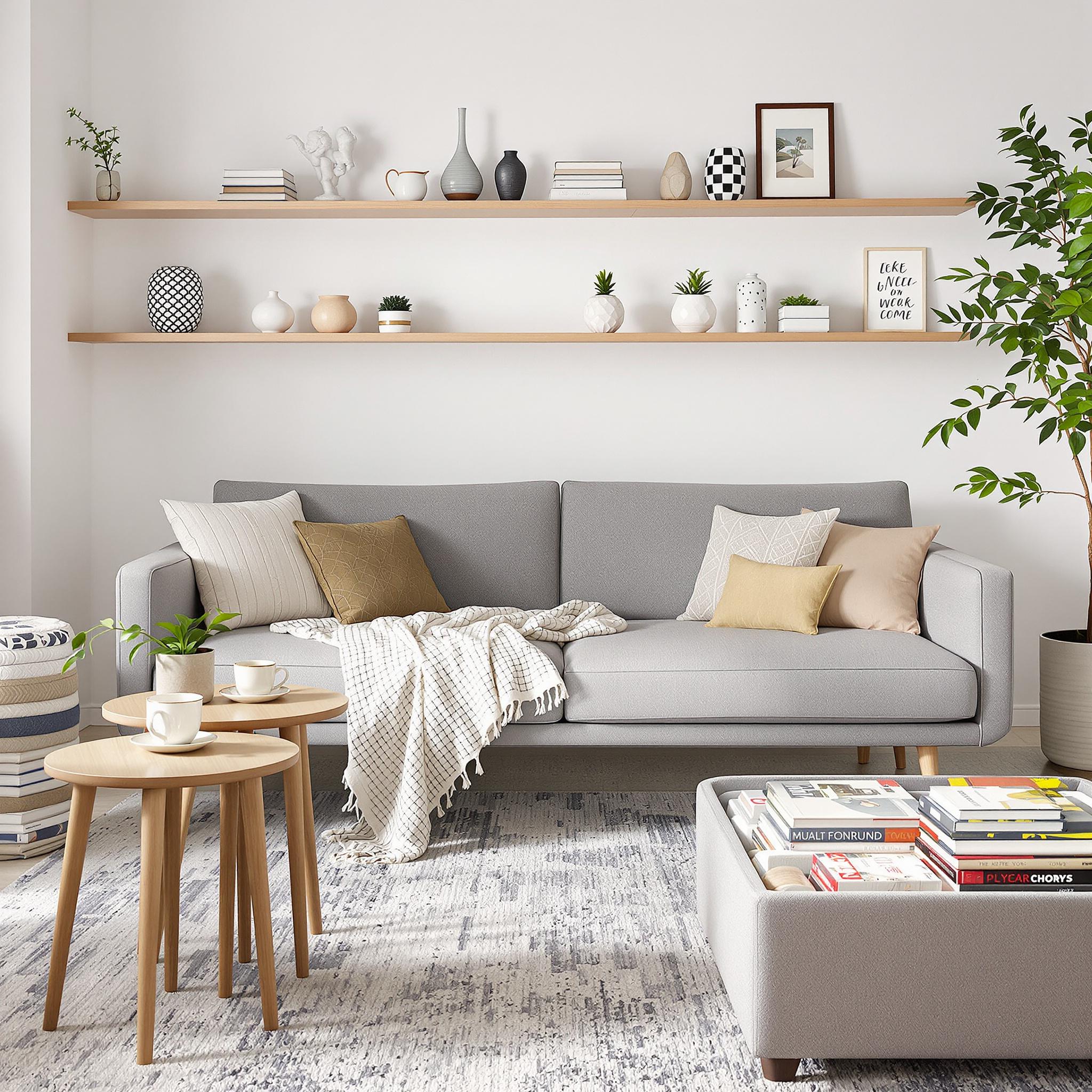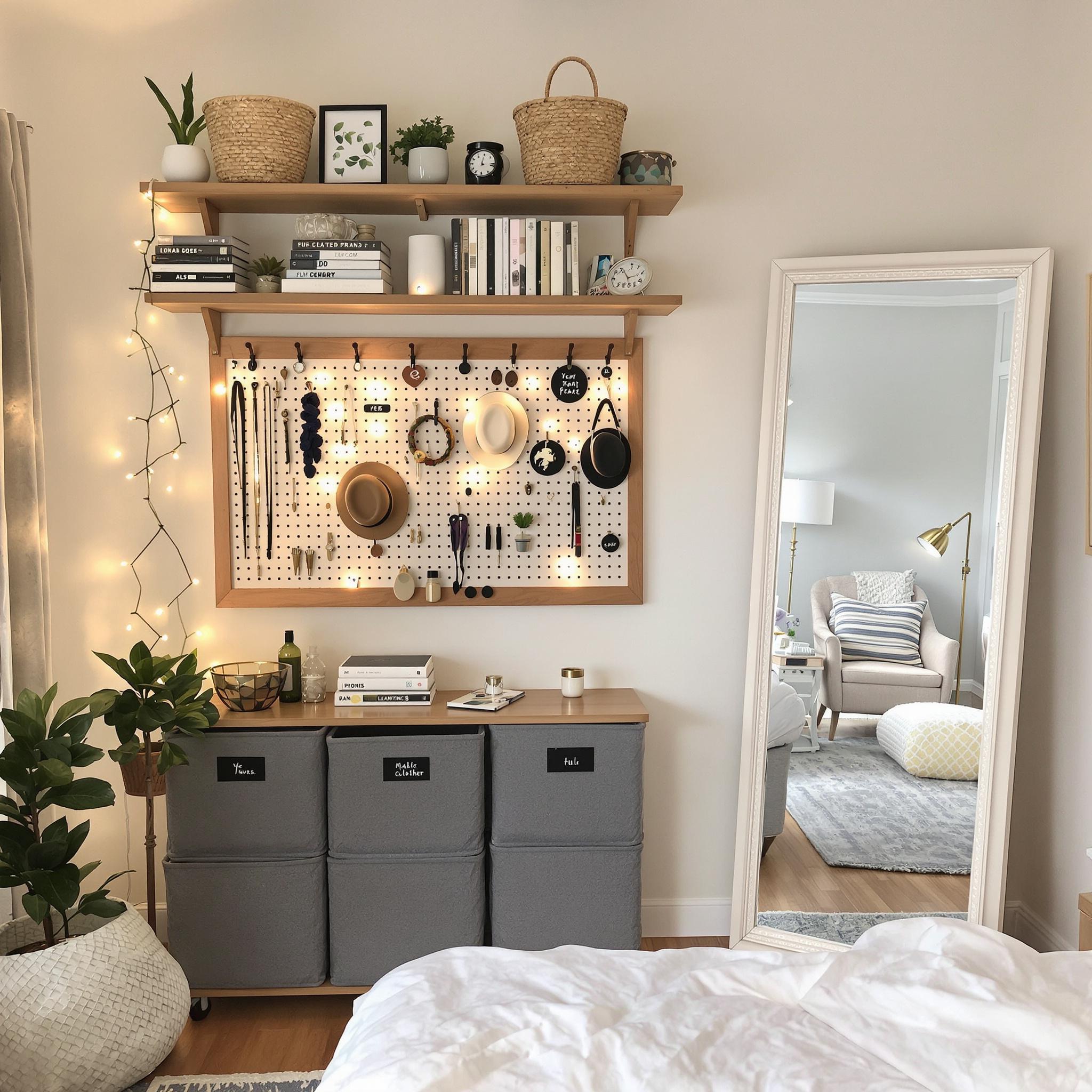What is Multi-Functional Decor and Why Does It Matter?
Multi-functional decor refers to furniture and design pieces that serve more than one purpose. A table that doubles as storage or a bed with built-in shelves are great examples. These items are becoming popular because they solve real problems in small spaces.
Small spaces often mean limited square footage and not enough storage. You might feel cramped or overwhelmed. The right decor can change that. Versatile pieces help you use every inch wisely. They also add style without clutter.
Think about studio apartments, tiny homes, or dorm rooms. These areas are tight by nature. Every piece of furniture needs to pull its weight. Multi-functional decor does just that. It makes your space work harder for you.
Challenges of Small Spaces
Tight areas come with unique challenges. Limited floor space is the biggest issue. Too much furniture can make a room feel crowded. Storage is another problem. Where do you put your stuff when there’s no closet space?
Poor layout choices can make things worse. A bulky couch or oversized table eats up valuable room. Even decor like lamps or rugs can feel out of place if they don’t serve a purpose. Without smart solutions, small spaces can feel chaotic.
The good news? Multi-functional decor tackles these issues head-on. It helps you stay organized while keeping your space stylish. You don’t have to sacrifice comfort or beauty for practicality.
Benefits of Versatile Decor Pieces
Versatile decor has clear benefits. First, it saves space. A sofa bed works as seating and a guest bed. A storage ottoman holds blankets but also acts as a footrest. These pieces do double duty.
Second, multi-functional decor enhances aesthetics. You can choose items that match your style. A sleek desk with hidden storage looks clean and modern. A bookshelf that doubles as a room divider adds charm.
Third, these pieces improve functionality. Need a workspace but lack room? A foldable desk solves the problem. Want extra seating without clutter? Stackable stools are perfect. Smart choices make daily life easier.
Examples of Tight Spaces That Need Solutions
Studio apartments are a classic example of tight spaces. Everything happens in one room. You need furniture that adapts. A Murphy bed folds away during the day. A dining table becomes a workspace at night.
Tiny homes face similar challenges. Space is precious. Multi-functional decor is essential here. Think loft beds with drawers underneath. Or kitchens with fold-down counters. These ideas make tiny living comfortable.
Dorm rooms are another tight spot. Students need desks, beds, and storage in a small area. Lofted beds free up floor space. Desks with shelves above keep books within reach. These solutions maximize every inch.
Transforming Small Spaces with Smart Ideas
You can transform tight spaces with a few key pieces. Start with storage beds. They hold clothes, books, or seasonal items. This keeps clutter off the floor.
Next, consider foldable furniture. A wall-mounted desk folds down when needed. It disappears when you’re done. This trick works in any small space.
Room dividers are another smart choice. Use shelves that act as walls. They separate areas while adding storage. Curtains or screens also work well.
Lighting matters too. Choose lamps with shelves or hooks. They brighten your space and hold small items. Every detail counts in tight areas.
Real-Life Inspiration for Your Space
A friend once turned her studio apartment into a dream space. She used a futon with storage arms. Her coffee table had a lift-top for meals. She even added hanging plants to save floor space.
Another example comes from a tiny home owner. He installed a drop-leaf table. It seats four when open but tucks away when not in use. His loft bed had stairs with built-in drawers. Clever ideas like these make a big difference.
You don’t need a huge budget to try these tips. Thrift stores often have versatile pieces. With a little creativity, you can find gems that work for your space.
Start Small and Build Smart
Begin with one or two multi-functional pieces. Add more as you go. Focus on what you need most. Maybe it’s a storage bench or a convertible desk.
Measure your space before buying anything. Make sure each piece fits your room. Avoid overcrowding. Less is more in tight areas.
Remember, your space reflects your personality. Choose items that speak to you. Multi-functional decor doesn’t have to be boring. It can be both practical and stylish.
- Pick furniture with hidden storage.
- Opt for foldable or stackable pieces.
- Use vertical space with shelves or hooks.
With these tips, you can create a space that works for you. Small doesn’t mean sacrificing comfort or style. Multi-functional decor proves that.
Multi-Functional Furniture That Saves Space and Looks Good Doing It
Let me tell you, moving into my tiny studio felt like a disaster waiting to happen. Clutter everywhere, no room to breathe. Then I stumbled on multi-functional furniture. Game changer. My place suddenly felt twice as big. Like magic.
Take sofa beds. They’ve come a long way from the lumpy ones at your grandma’s house. Sleek, stylish, comfy—perfect for small spaces. A friend got this mid-century modern pull-out couch. You’d never know it turns into a bed unless she told you. Quick tip: Test how easy it is to unfold. Wrestling with a stubborn mechanism at midnight? Not fun.
Foldable tables are lifesavers too. I have this little wooden one that stays folded against the wall most of the time. When I need extra space—for meals, crafts, or just sorting mail—it pops out. Bonus: It doubles as a bar during dinner parties. Who knew a $50 table could make me feel so fancy?
Nesting tables are another win. Multiple surfaces, minimal space. Use them separately or stack them up. They come in all kinds of styles—industrial, boho, whatever you’re into. Functional *and* stylish.
Clever Storage Solutions That Keep Clutter Out of Sight
Storage might sound boring, but it’s not. Finding ways to hide your stuff can actually be kinda fun. Did you know ottomans can hold stuff? I didn’t either until I bought one. Now it’s home to all my throw blankets and board games. My living room went from chaotic to chill real quick.
Wall-mounted shelves are awesome too. They keep things off the floor and add personality. I put floating shelves above my desk for books, plants, and random knick-knacks. People always compliment how cozy and organized it feels. Win-win.
Don’t forget under-bed storage bins. Perfect for seasonal clothes, extra bedding, or those items you don’t use often. I once stored Christmas decorations under my bed. Saved me from cramming everything into a closet corner where it’d get forgotten.
Here’s the thing: storage should look good too. Match it to your style. Minimalist? Go for sleek cabinets. Eclectic? Try colorful baskets or patterned boxes. Either way, it should blend in, not stick out.
Decorative Elements That Make Small Spaces Feel Bigger
Mirrors are magic for small spaces. Hang one strategically, and boom—your room feels twice as big. The mirror in my entryway makes my tiny foyer feel grand. Place it opposite a window or light source for max effect.
Dual-purpose rugs are great too. Define areas in an open layout or warm up hardwood floors. Need to separate your living area from your dining nook? A well-placed rug does the trick. Textured rugs add depth without overwhelming the space.
Lighting matters. String lights aren’t just for dorm rooms—they create instant coziness. I draped fairy lights around my bookshelf once, and the whole room felt warmer. Adjustable table lamps are practical too. They give task lighting without taking up much space.
Funny story: I tried oversized artwork in my tiny bedroom. Big mistake. Smaller frames grouped together worked way better. Gallery walls are perfect for adding interest without making a room feel cramped. Mix photos, prints, and small objects like clocks or mirrors.
Tips for Choosing the Right Pieces—and Making Them Work
Not every multi-functional piece will work for your space. Before shopping, think about what you need. Measure your rooms, note problem areas, and consider how you live day-to-day. Entertain often? Need workspace? Prefer calm vibes? Your answers matter.
Versatility is key. Look for pieces that adapt. A dining table with drop leaves expands when needed but stays compact otherwise. Stackable or foldable chairs are great too. They maximize flexibility.
Scale matters. Bulky furniture can overwhelm a small room. Go for streamlined designs and lighter materials like rattan or acrylic. A glass-top coffee table feels airier than a solid wood one, even if they’re the same size.
Color plays a role too. Lighter hues recede visually, making spaces feel bigger. But you don’t have to stick to white or beige. Add accent colors sparingly—like on a chair or through accessories.
Real-Life Application Ideas to Inspire You
Still not sure how this works? Let me paint a picture. Imagine a studio apartment. A Murphy bed folds into a couch during the day. Nearby, a slim console table holds keys and mail but folds out into a dining table for two. Wall-mounted shelves display books and plants, keeping the floor clear. A large mirror reflects natural light, making the space glow.
Or think about a kid’s room. A loft bed leaves room underneath for a desk, toy storage, or a reading nook. Add a chalkboard wall for creativity. A functional space that grows with your child.
Even bathrooms can benefit. Swap bulky towel racks for hooks inside cabinet doors. Install a mirrored medicine cabinet to save counter space. If space is tight, try a shower caddy that hangs over the faucet instead of sitting on the floor.
Bottom line? With creativity and smart planning, even the tiniest space can become functional and stylish. If I can do it in my shoebox studio, anyone can.
Tips for Seamlessly Integrating Multi-Functional Decor
So, you’ve got the basics down—multi-functional decor is key in small spaces. But how do you make it work without your home looking like a storage unit? Balance is everything. I once tried to cram every clever idea into my studio apartment and ended up with a chaotic mess. Lesson learned: less really is more.
Start by thinking vertically. Wall shelves are lifesavers. They add storage and draw the eye upward, making the room feel bigger. Floating shelves above your desk or couch can hold books, plants, or even a mini coffee station. Pro tip: keep heavier items on lower shelves to avoid that top-heavy look. And don’t forget baskets—they hide clutter while staying stylish.
Budget constraints? No problem. Thrift stores are treasure troves. A fresh coat of paint can transform an old side table or bookshelf. I once found a vintage ladder for $10 at a flea market, turned it into a blanket rack, and it’s still one of my favorite pieces.
Budget-Friendly DIY Projects to Try
Let’s talk DIY. If you’re anything like me, you’ve scrolled through Pinterest dreaming of those perfect spaces. The good news? Many ideas are totally doable, even if you’re not handy. For example, take a plain wooden crate. Sand and stain it, and it becomes a chic side table with hidden storage. Feeling ambitious? Stack two crates, add wheels, and you’ve got a rolling nightstand.
Funny story: I once tried to build a fold-down desk from scratch. It ended up wobbly and unusable. Moral of the story? Start small. Try beginner-friendly projects like turning an old door into a headboard or using mason jars as wall organizers. These upgrades make a big impact without driving you crazy.
Lighting matters too. Harsh overhead lights can kill the vibe. Swap them out for warm options like string lights, floor lamps, or candles. Soft lighting makes a space cozier and highlights your decor. Plus, it’s a great excuse to buy those cute lanterns you’ve been eyeing.
Avoiding Common Pitfalls in Small Spaces
Let’s get real. There are mistakes people often make when trying to maximize small spaces. I’ve made most of them. First, overcrowding. It’s tempting to fill every inch, but this just makes the space feel cramped. Stick to a few key multi-functional pieces. Breathing room is your friend.
Over-accessorizing is another trap. That quirky knick-knack might seem cute, but if it doesn’t serve a purpose, it’s taking up valuable space. Be ruthless about what stays. I had a rule: no new item without removing an old one. It worked wonders.
Don’t underestimate mirrors. They’re not just for checking your outfit—they make a room feel bigger. Hang a large mirror opposite a window to bounce light around. Or lean a full-length mirror against the wall. Simple trick, big impact.
Layering Functionality Without Sacrificing Style
Here’s where it gets fun: layering functionality. Think about how each piece can do double duty. A storage ottoman? Perfect for blankets and extra seating. A pegboard in the kitchen? Stylish and practical for utensils. Even your bed can multitask—add drawers underneath for hidden storage.
Color matters too. Neutral tones create calm and openness. But you don’t have to stick to boring beige. Add pops of color with throw pillows, rugs, or artwork. My trick? A brightly colored chair that doubles as seating and a statement piece. Win-win.
I used to think curtains were just for windows. Then I discovered how great they are for dividing spaces. Hang a curtain rod across a corner, and you’ve got a makeshift closet or reading nook. Match the fabric to your decor, and it blends right in.
Your Checklist for Redesigning Tight Areas
Ready to redesign? Here’s a quick checklist to stay on track:
- Assess your needs: What functions does your space need to serve?
- Prioritize multi-functional furniture.
- Go vertical with shelves and hooks.
- DIY where possible to save money.
- Use mirrors to create the illusion of space.
- Stick to a cohesive color palette.
- Edit ruthlessly—keep only what you love and use.
- Add layers of lighting for warmth and depth.
- Avoid overcrowding and over-accessorizing.
- Test your layout before committing to big changes.
Final Thoughts
Designing a small space is all about creativity and intention. It’s not about having the most stuff—it’s about making every piece count. Whether you’re redoing a studio apartment or tweaking your living room, simplicity and functionality can go hand in hand. Take a deep breath, trust your instincts, and enjoy the process. Your space should reflect *you*.
Frequently Asked Questions
- How do I choose the right multi-functional furniture?
Look for pieces that solve specific problems, like a sofa bed for guests or a dining table with built-in storage. Measure your space first to ensure it fits comfortably. - What’s the best way to store items in a small bedroom?
Use under-bed storage bins, wall-mounted shelves, and slim-profile dressers. Avoid bulky furniture that eats up floor space. - Can I use bold colors in a small space?
Absolutely! Just use them sparingly. A bold accent wall or colorful accessories can add personality without overwhelming the room. - How do I avoid making my space feel cluttered?
Stick to a minimalist approach. Keep surfaces clear, edit your belongings regularly, and invest in smart storage solutions. - Are there budget-friendly ways to update my decor?
Definitely. Try painting old furniture, shopping secondhand, or swapping out hardware on cabinets and drawers for a fresh look. - What’s the easiest DIY project for beginners?
Start with something simple, like creating a gallery wall or turning mason jars into organizers. These projects require minimal tools and skills. - How can I divide a studio apartment into zones?
Use rugs, curtains, or bookshelves to create visual boundaries between areas like sleeping, working, and lounging. - Is it worth investing in custom furniture?
If you plan to stay in the space long-term, yes. Custom pieces can maximize awkward corners and fit your exact needs. - What’s the biggest mistake people make in small spaces?
Overcrowding is the #1 culprit. Too much furniture or decor can make a room feel chaotic and cramped. - How do I maintain visual appeal while maximizing functionality?
Focus on clean lines, cohesive colors, and dual-purpose items. Decorate with purpose, choosing pieces that are both beautiful and practical.



